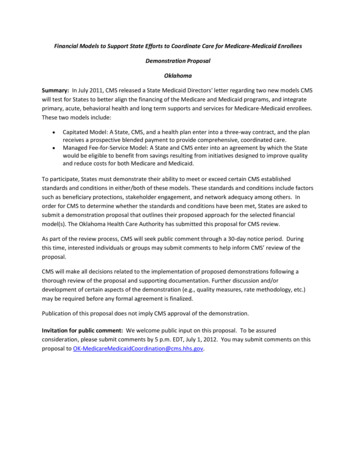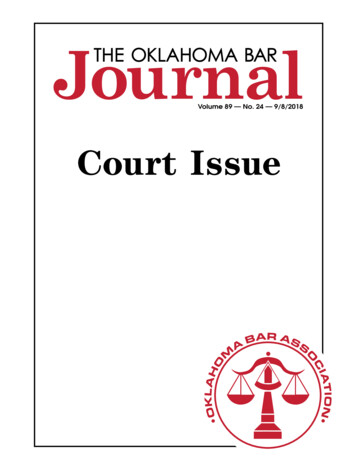
Transcription
Financial Models to Support State Efforts to Coordinate Care for Medicare-Medicaid EnrolleesDemonstration ProposalOklahomaSummary: In July 2011, CMS released a State Medicaid Directors' letter regarding two new models CMSwill test for States to better align the financing of the Medicare and Medicaid programs, and integrateprimary, acute, behavioral health and long term supports and services for Medicare-Medicaid enrollees.These two models include:Capitated Model: A State, CMS, and a health plan enter into a three-way contract, and the planreceives a prospective blended payment to provide comprehensive, coordinated care.Managed Fee-for-Service Model: A State and CMS enter into an agreement by which the Statewould be eligible to benefit from savings resulting from initiatives designed to improve qualityand reduce costs for both Medicare and Medicaid.To participate, States must demonstrate their ability to meet or exceed certain CMS establishedstandards and conditions in either/both of these models. These standards and conditions include factorssuch as beneficiary protections, stakeholder engagement, and network adequacy among others. Inorder for CMS to determine whether the standards and conditions have been met, States are asked tosubmit a demonstration proposal that outlines their proposed approach for the selected financialmodel(s). The Oklahoma Health Care Authority has submitted this proposal for CMS review.As part of the review process, CMS will seek public comment through a 30-day notice period. Duringthis time, interested individuals or groups may submit comments to help inform CMS’ review of theproposal.CMS will make all decisions related to the implementation of proposed demonstrations following athorough review of the proposal and supporting documentation. Further discussion and/ordevelopment of certain aspects of the demonstration (e.g., quality measures, rate methodology, etc.)may be required before any formal agreement is finalized.Publication of this proposal does not imply CMS approval of the demonstration.Invitation for public comment: We welcome public input on this proposal. To be assuredconsideration, please submit comments by 5 p.m. EDT, July 1, 2012. You may submit comments on thisproposal to OK-MedicareMedicaidCoordination@cms.hhs.gov.
Oklahoma Proposal for State Demonstrations to Integrate Care for Dual Eligible IndividualsState Demonstrations to Integrate Care for Dual Eligible IndividualsThis document is Oklahoma‘s proposal for ―State Demonstrations to Integrate Care for Dual EligibleIndividuals‖. The document describes in detail how the Oklahoma Health Care Authority (OHCA),Oklahoma‘s single state Medicaid agency, will implement and operate an integrated delivery system andpayment model aimed at improving the quality, coordination, and cost-effectiveness of care for dualeligible individuals. Through the submission of this proposal to the Center for Medicare and MedicaidInnovation (CMMI), Oklahoma is pursuing a three-pronged approach for integrating care for the state‘sdual eligible population.1) Oklahoma‘s care coordination program design fully integrates the health services deliverymechanisms for Medicare and Medicaid (known as SoonerCare in Oklahoma) for Oklahoma‘sdually eligible members. By looking at claims and working with an interdisciplinary care team, thisapproach creates the ability to better manage a dually eligible member‘s care. This level ofintegration will create a better understanding of benefits and services available to those served bySoonerCare and Medicare. Through the newly developed care coordination program, OHCA seeksto improve member access to appropriate services, integrate a comprehensive range of services forindividuals, and create significant cost savings.2) In partnership with the University of Oklahoma School of Community Medicine at Tulsa (SOCM),the second approach to care integration that Oklahoma is pursuing is a multi-tiered approach to carecoordination by focusing on a) the redesign of the practice to incorporate behavioral health and carecoordination services, b) the inclusion of population level clinical analytics to facilitate themanagement of the population, c) the use of community level integrated care plans, d) thedevelopment of community level evidence based protocols in the management of chronic disease,and e) the integration of these methodologies into graduate medical education.3) Oklahoma‘s final approach to the integration of care for duals involves the creation of an IntegratedCare Sites (ICS) demonstration design that would utilize the proven infrastructure of the Program ofAll Inclusive Care for the Elderly (PACE) model, while making some modifications to the existingPACE criteria. The ICS will allow for a greater number of individuals to benefit from the provenhigh quality of care received through the integrated care system of the PACE model. The ICSdemonstration is an effort to display ways that will enhance the scalability and effectiveness of thePACE model.Concept #1- SoonerCare SilverExecutive SummaryIn order to more efficiently provide quality health care to our dual eligible population, the OHCA hasdesigned a model of care coordination services. This model will impact the health outcomes for thetarget population by improving care management and access, while reducing costs by improvingefficiency and reducing duplication of services. Care for the dual eligible population has historicallybeen fragmented with services often duplicated, gaps in care and overall poor health outcomes.The OHCA care coordination program known as ―SoonerCare Silver‖ aims to improve the integration ofcare by adding care coordination to the infrastructure of services a dually eligible member currentlyreceives. The care coordinator will serve as a bridge between Medicare, Medicaid, providers and themember to improve communication, reduce redundancies and help to ensure the member is receiving allthe quality care he or she needs. This care will center on an Interdisciplinary Care Team (ICT) that will1
Oklahoma Proposal for State Demonstrations to Integrate Care for Dual Eligible Individualswork collectively to develop and implement the member‘s action plan to achieve a positive healthoutcome.Table 1: Care Coordination Overview ChartTarget Population (All full benefit Medicare-Medicaid enrollees/ All full benefit Medicare-Medicaid enrolleessubset/etc.)Total Number of Full Benefit Medicare-Medicaid79,891Enrollees StatewideTotal Number of Beneficiaries Eligible for Demonstration 79,891Geographic Service Area (Statewide or listing of pilot serviceStatewideareas)Along with existing Medicare and Medicaid healthSummary of Covered Benefitsbenefits, care coordination services will be offered tothe eligible full benefit Medicare-Medicaid enrollees.Financing ModelFee-for-ServiceFull Stakeholder Meetings: September2011thruMarch 2012Workgroup meetings: October2011 thru FebruarySummary of Stakeholder Engagement/Input2012(Provide high level listing of events/dates—Section D asks for moreMember/Caregiver Focus Groups:February 2012detailed information)Stakeholder Proposal Review Session:March-May2012Proposal Posted for Public Comment: April 20, 2012Proposed Implementation Date(s)July 2013BackgroundOklahomans who are considered to be full benefit dual eligible members receive services from bothMedicare and SoonerCare. Individuals considered Specified Low-income Medicare Beneficiaries(SLMB) only and Qualifying Individuals (Q1) are not considered ―full benefit‖ duals. The bulk ofMedicare spending is for physician visits, inpatient, outpatient, hospital services, prescription drugcoverage, and skilled nursing; the bulk of Medicaid spending for dually eligible individuals is for longterm care services. Fragmented care and lack of coordination between Medicare and Medicaid servicesoften lead to poor health outcomes, and extremely high costs. Recently, national attention is beingdirected to the utilization patterns and rate of expenditures for this population.In response to the opportunity provided by CMMI, the OHCA seeks to better coordinate care for duallyeligible SoonerCare members by utilizing proven strategies to overcome barriers to effective health caredelivery services resulting in 1) integrated access to primary care and behavioral health services, 2)improved care coordination and health outcomes and 3) reduced costs for care to the target population.The Oklahoma care coordination program seeks to respect the differences between Medicare andSoonerCare while providing care coordination at the point of member access to services through the twohealthcare systems. Through the implementation of this program, these dually eligible SoonerCaremembers will have a care coordination process that connects duals to their health providers in anefficient and culturally competent fashion; connects new dual eligible members to the service deliverysystem as quickly as possible; and offers ongoing assistance to navigate both Medicare and Medicaid.Historically, barriers to effective care coordination between Medicare and Medicaid have beendifferences in benefits, different billing systems, different processes for eligibility, enrollment andappeals, and different payment methodologies. Care coordination of services will reduce memberbarriers to gaining information, and allows members to have an initial awareness of the comprehensive2
Oklahoma Proposal for State Demonstrations to Integrate Care for Dual Eligible Individualsbenefits that are afforded them through combined benefit offerings. Care coordination program staff candirect members to physicians and providers who have agreed to serve people who are dually eligible,and who are more thoroughly educated about the complex health needs of duals and frequentlyreoccurring comorbidities.Figures from March 2011 SoonerCare fact sheet and the Medicare Resource Center indicates that of the727,369 SoonerCare members, and 607,465 Medicare members, there were 7.8% or 104,538 peoplewho were eligible in both categories at the same time, and are called dually eligible1. In June 2011,there were 79,891 full benefit Medicare-Medicaid enrollees statewide2. Total enrollment for dualeligible SoonerCare members are comprised of Caucasian 77.9%, Hawaiian or other Pacific Islander1%, African American 12.5%, Asian 1.3%, American Indian 7.5%, and those with multiple races are0.7%3. By age and gender, the demographics of this population are: females 65 and older-36%; femalesless than 65 years-27%; males 65 and older-15%; and males less than age 65 -22%4.The dual eligible population has higher rates of poor health than those members on just Medicare orSoonerCare. They are characterized as weak, frail, and having multiple chronic conditions. They alsomay be lower functioning, have mental and behavioral health impairments and have a higher rate ofbeing low-income5. Analysis of SoonerCare claims for dual eligible members supports national trendingin categories of services delivered and rate of expenditures. Dual eligible members present a challengeas they constitute a small percentage of the SoonerCare population, but represent a much higherpercentage of spending. Looking at those without existing case management services, 62 percent werecharacterized by high per member per month spending with high rates of inpatient, outpatient, SkilledNursing Facility (SNF) and/or physician utilization. The top 10 costliest conditions for all dual eligiblesare presented in appendix A in more detail.The chart below describes an internal analysis of Long-term Care Support (LTSS) services for allOklahoma duals as of June 2011:Chart 1- Long Term Care Support Services AnalysisOverall Individuals receivingIndividuals receivingLTSS in institutionalLTSS in HCBS settingssettingsOverall total105,532 13,48621,821Individuals age 65 54,31310,70912,028Individuals under age 6551,2192,7779,793Individuals with a serious mental 8,4213831,085illnessother6,953Care Model OverviewOklahoma‘s 77 counties are categorized as urban, rural and mixed (urban and rural). The four urbancounties, Cleveland, Comanche, Oklahoma and Tulsa account for 45.4% of the state‘s population.Another 8.9% of the population lives in one of the five mixed counties, Canadian, Logan, Creek,McClain and Wagoner, with the remaining 45.7% of the state‘s citizens living in one of the remaining68 rural counties6. The Oklahoma SoonerCare Silver care coordination program will cover dual eligiblemembers residing in all of Oklahoma‘s counties with limited exceptions.1Retrieved from the Medicare Resource Center http://www.medicareresources.org/oklahomaJune 2011 Internal document with detailed analysis pulled from SoonerCare enrollment records.June 2011 Internal document with detailed analysis pulled from SoonerCare enrollment records.4June 2011 Internal document with detailed analysis pulled from SoonerCare enrollment records. **Data extracted for Race and Age details were at adifferent point in time than overall numbers.5Kaiser Family Foundation, 20076Retrieved from State of the State‘s rural Health mapshow/images/07-CntyClass lg.jpg233
Oklahoma Proposal for State Demonstrations to Integrate Care for Dual Eligible IndividualsIndividuals receiving care coordination through other programs such as Tulsa‘s Health Innovation Zone(THIZ), PACE and the ICS will be excluded from the SoonerCare Silver care coordination program. Allother dual eligible individuals who are not receiving care coordination services through their currentbenefit program will be eligible to receive care coordination through the SoonerCare Silver program.General eligibility information is summarized in the following table. Complete Medicare and MedicaidEligibility guidelines are described in Appendix B.Table 2-Eligibility CriteriaMedicareMedicaidGenerally, you are eligible for Medicare if you or your In general, the following groups of individuals mayspouse worked for at least 10 years in Medicare- qualify for SoonerCare services:covered employment and you are 65 years or older and Adults with children under 19a citizen or permanent resident of the United States. If Children under 19 and pregnant womenyou are not yet 65, you might also qualify for coverage Individuals 65 and olderif you have a disability or with End-Stage Renal disease Individuals who are blind or who have disabilities(permanent kidney failure requiring dialysis or Women under 65 in need of breast or cervical cancertransplant).treatmentThere are conditions and guidelines for obtaining Part Sooner Plan - Men and women 19 and older with familyA benefits at age 65 without having to pay premiums. planning needsThere are conditions and guidelines for obtaining Part In addition to the citizenship and the state residencyA benefits under age 65 without having to payrequirements, a SoonerCare applicant must meetpremiums.categorical and financial requirements.SoonerCare Income Guidelines are available on OHCA‘swebsite http://www.okhca.org/As a part of the proposed care coordination program, individuals eligible for full benefits of Medicaidand Medicare will automatically be enrolled in the SoonerCare Silver program. Members will berequired to make a decision and take action to opt out of the program, should they choose to no longerparticipate and be contacted by a care coordinator. Outreach and education of potential members priorto auto-enrollment in SoonerCare Silver will be detailed in the three way contract between an outsidevendor, OHCA, and CMS.Oklahoma‘s care coordination model for duals will benefit from a well-established network of supportfor implementation, with a variety of proven programs that provide long-term care services and supportfor dual eligible members. These members will now be offered the additional service of carecoordination, as an overlay for long-term care and waiver participants. The added benefit of carecoordination will become the hub of what links all of the member‘s services together. The carecoordinator will work directly with individuals and those who provide services for a dual eligible, suchas the nurse case manager, social worker and other providers who are currently providing services to themember. For all members, no changes will be made to coverage for existing Part D services. Carecoordinators will help members navigate Part D services as needed. The care coordinator will also serveas a liaison to the ICT to ensure the best plan of care for the individual member residing in thecommunity or a facility.The SoonerCare Health Management Program (HMP) is an example of a successfully operated OHCAcare management program. This program utilizes a two-armed approach. Currently, selectedSoonerCare Choice Primary Care Providers (PCPs) are offered one-on-one staff assistance, called―practice facilitation‖. Providers are generally selected for the program through predictive modelingsoftware that identifies them to have a panel of patients with high chronic disease burden. In general,4
Oklahoma Proposal for State Demonstrations to Integrate Care for Dual Eligible Individualspractice facilitators collaborate with PCPs and their office staff to improve their efficiency and quality ofcare through implementation of enhanced disease management protocols and improved patient trackingand reporting systems7. The second arm of the HMP is Nurse Care management. This program isoffered to 5,000 SoonerCare Choice members with chronic disease determined by predictive modelingsoftware to be at highest risk. These members receive a comprehensive assessment which results ineducation, an individualized action plan and self-management supports.Lessons learned from OHCA‘s HMP will be incorporated into the care coordination program, providingappropriate and proficient services that address the needs of the Medicare and Medicaid population.People who are dually eligible, even those with the most complex health needs, are excluded from HMP.But, the HMP has developed effective protocols for addressing the health needs that can be modeled forthe dually eligible. Such medical and supportive services can be used with the dual eligible populationto identify opportunities for intervention within the care coordination program.Another successful care management program administered by OHCA is SoonerCare Care Management(SCCM). SCCM is for members who have complex medical and behavioral health needs who aredirected to specific programs that address their exceptional health care needs and accompanying costs.SCCM targets specific health issues for members including, but not limited to: the coordination of out ofstate care; breast and cervical cancer; high risk obstetrics and pregnancies; hemophilia; at-risk infantsand early childhood mortality prevention; coordination of bilingual services, and a range of referrals forsupportive services, such as private duty nursing; assessment of waivers, and some in home assessments.OHCA is currently partnering with the State Mental Health Authority (SMHA) and the OklahomaDepartment of Mental Health and Substance Abuse Services (ODMHSAS) to implement the healthhomes model. Health homes are designed to serve people with chronic mental illnesses. Childrendiagnosed as Serious Emotional Disturbance (SED) - the term used to describe children who qualify,and Seriously Mentally Ill (SMI) - the term for qualifying adults are served by a nurse care manager,who coordinates a team of professionals that determine the best services for the member.Health homes will be hosted by ODMHSAS through the statewide network of community mental healthcenters (CMHCs) and their satellite locations, which have historically provided community-basedmental health services. The CMHCs provide screening, assessment and referral services, emergencyservices, therapy, psychiatric rehabilitation, case management, and other community support servicesdesigned to assist adult mental health consumers with living as independently as possible and to providetherapeutic services for children who are demonstrating symptoms of emotional disturbance. AllCMHCs provide services to both adults and children.With the integration of health homes, the CMHC‘s will have the additional offering of providing wraparound comprehensive behavioral health services to eligible members with an established PCPrelationship. There are fifteen CMHCs, five of which are state-operated facilities and the other ten arecontracted non-profit providers, together they provide services in all 77 counties in Oklahoma. Mostcenters have satellite offices or other specialized programs within their service areas. Projections aboutnumbers of health homes participants indicate approximately 1400 adults are estimated to be dualeligible. CMHCs and their service areas can be viewed as Appendix C, or at ODMHSAS‘ websitehttp://ok.gov/odmhsas/.Another community support program for children with behavioral health conditions is Systems of Care.The purpose is to reduce inpatient hospitalization with a team comprised of the member, a Care7SoonerCare HMP Evaluation5
Oklahoma Proposal for State Demonstrations to Integrate Care for Dual Eligible IndividualsCoordinator (CC), a Family Support Provider (FSP), OKDHS Child Welfare Worker, counselor,teacher, and others. A care plan is developed and each person on the team is responsible for a task to becompleted. Weekly visits by the CC and FSP to the member are maintained and the team meets once amonth.As identified earlier, these programs are not specifically targeted towards members who are duallyeligible, (HMP excludes dual eligibles altogether, and SCCM serve some duals but not exclusively)these programs still provide a rich array of information that can be used to significantly improve thedelivery of all Medicare and Medicaid services. As well as provide an improved response to the needfor a complex care continuum, based on their respective program‘s steady responses to a population whoresides in the same state, and whose health needs are strikingly similar. Health Homes and Systems ofCare are additional programs that will help provide a framework of information for providing carecoordination to the duals.Roughly, 35,000 duals are enrolled in either a waiver or long-term care program. Through theseprograms, members are offered case management services. While case management provides some helpwith support services and other programs along with monitoring a member‘s health and welfare, casemanagement does not offer clinical disease management services.A care coordinator monitoring a dual enrolled in a waiver or long term-care program, may offer servicescomplementary to existing services with the added benefit of disease management. For example,individuals with End-Stage Renal Disease (ESRD) and mental disabilities are assigned a carecoordinator who knows how to handle these complex issues. The care coordinator will be responsiblefor working with the ICT to come up with an action plan specific to these individual‘s needs. Noservices will be added to those with End Stage Renal Disease and mental disabilities other than layeringcare coordination on their existing services.These individuals would benefit from the care coordination program, because services they wouldreceive would be oriented toward quality oversight and addressing gaps in their existing care. Carecoordination will not duplicate existing services given to a member. Those members not in a waiver orHCBS, will receive the full services of care coordination encompassing both Medicare and Medicaidsavings.8 Table 3 outlines the Waiver and Long-term services that may already be provided to a dualeligible member; notice none are receiving disease management services.Table 3-Summary of Waiver and Long-Term Care Programs in Oklahoma (Publicly Funded)TargetedNameOperatorServices Funding Case Management Services ProvidedPopulationCase managers from private industry provideragencies develop a waiver services plan that takesElderly,into account the member‘s informal supports andAdvantageOKDHSphysicallyHCBS OKDHS other programs. These providers are responsibleWaiverAgingdisabled 21 for monitoring the adequacy of the plan and themember‘s health and welfare. Disease managementis not in case management scope.Community OKDHS- MR/DD ages 3For each of these waiver programs, State agencyHCBS OKDHSWaiverDDSDand oldercase managers develop service plans, which includeresidential services. These case managers areHomewardOKDHSBoundClass members HCBS OKDHS responsible for monitoring the adequacy of the planDDSDand the member‘s health and welfare. DiseaseWaiver8PHPG6
Oklahoma Proposal for State Demonstrations to Integrate Care for Dual Eligible IndividualsNameIn-homeSupports forAdultsWaiverIn-homeSupports s Funding Case Management Services Providedmanagement is not in case management scope.OKDHS- MR/DD 18 andHCBSDDSDolderOKDHSOKDHS- MR/DD ages 3HCBSDDSD17OKDHSOHCAOLL55 and olderMedicare The PACE provider furnishes case managementCapitated&and is responsible for development of a servicemodelMedicaid plan.LivingOHCAChoiceOLLdemonstration19 and olderHCBSPACEMy Life; icallyFragileWaiverOHCAOLLLiving Choice(MFP)graduates withHCBSphysicaldisabilities andyounger than 65Living Choice(MFP)HCBSgraduates whoare 65 and older19 and olderHCBSOHCAOHCAOHCAFor these waiver programs, case managers fromprivate industry provider agencies develop atransition/community plan that takes into accountthe member‘s informal supports and otherprograms. These providers are responsible formonitoring the adequacy of the plan and themember‘s health and welfare. Disease managementis not in case management scope.OHCAMember is admitted to facility under physician‘sorders and is monitored 24/7 by staff. A MinimumNursingData Set is completed and the care plan isFacilities or OHCAOHCAdeveloped accordingly. The MDS is reviewed atICFs-MRleast quarterly or when a significant change in themember‘s condition occurs.Nurses from private industry provider agenciesdevelop a personal care services plan that takes intoaccount the member‘s informal supports and otherprograms. These providers are responsible forState PlanOKDHSPersonalmonitoring the adequacy of the plan and theAll agesOKDHSPersonal Care Agingcaremember‘s health and welfare. Disease managementis not in the scope of personal care services. Inaddition, the State agency nurse who assesses themember performs ongoing monitoring and makes adetermination regarding level of care.Key terms: OKDHS- Oklahoma Department of Human Services; HCBS- Home & Community Based Services;OKDHS/DDSD- Developmental Disabilities Services Division; MR/DD- Mentally Retardation/DevelopmentallyDisabled; OLL- Opportunities for Living Life; MFP- Money Follows the Person; ICF-MR- Intermediate CareFacilities for Mental Retardation7
Oklahoma Proposal for State Demonstrations to Integrate Care for Dual Eligible IndividualsOnce the dual eligible member is enrolled in SoonerCare Silver and agrees to care coordination, the carecoordinator will review the member‘s current level of participation to determine if the member isalready enrolled in any existing program. The care coordinator will specifically check other OHCAprograms, to determine if the member is engaged with a) current Medicaid waivers and/or State planservices available to this population; (b) existing managed long-term care programs; (c) existingspecialty behavioral health plans; (d) integrated programs via Medicare Advantage Special Need Plans(SNPs) or PACE programs, and (e) other state payment/delivery initiatives or demonstrations. The carecoordination staff can monitor the member‘s participation through the case manager or through casemanagement electronic data access. Table 4 below is an overall comparison of expenditures andutilization rates for the dually eligible.In an analysis by the Pacific Health Policy Group (PHPG), members can be separated by four distinctpopulations.1) Frail elderly and persons with physical disabilities enrolled in the ADvantage Home andCommunity Based Services (HCBS) waiver;2) Nursing facility residents;3) Persons with developmental disabilities, including those enrolled in the DevelopmentalDisabilities Service Division (DDSD) waiver;4) ―Target‖ group consisting of persons not falling into one of the first three categories.Table 4- Summary Comparison of Enrollment, Expenditures and Utilization Rates (CY 2009)TotalTotalChronically Medicare Total Medicare/Total IPTotal SNFOPPMPMPhysicianPopulation Ill Dual MemberMedicaidAdmissions VisitsDaysSpendingVisitsEligibles MonthsSpendingper 1,000per1,000perper 1,0001,000Target48,423550,730 742,405,173 1,3484284,0736856,073ADvantage17,807202,190 749,839,047 3,7099276,1303,5378,183Nursing10,685112,872 596,809,419 5,2871,1027,44116,1511,892FacilityDD1,20013,937 92,656,620 29 2,181,710,259 2,4806275,0393,3195,982)Until this point, this document has referenced existing supports for dual eligible members. This sectionwill briefly describe potential sources of support that have been available, but have historically served aslightly different purpose in the dual eligible service system, and will require a new approach to solve anold problem.ER Utilization ProgramPeople who are dually eligible often have high rates of emergency room participation and hospitaladmissions. As a part of implementing this proposal, traditional relationships with hospitals and theirprofessional associations will need to be strengthened. The hospitals serve as a significant provider ofmedical services to the dual population and SoonerCare. An opportunity is now presented to discusshospitalization and related issues with hospital administrators, focusing on methods that challengeinappropriate hospital u
Innovation (CMMI), Oklahoma is pursuing a three-pronged approach for integrating care for the state's dual eligible population. 1) Oklahoma's care coordination program design fully integrates the health services delivery mechanisms for Medicare and Medicaid (known as SoonerCare in Oklahoma) for Oklahoma's dually eligible members.










